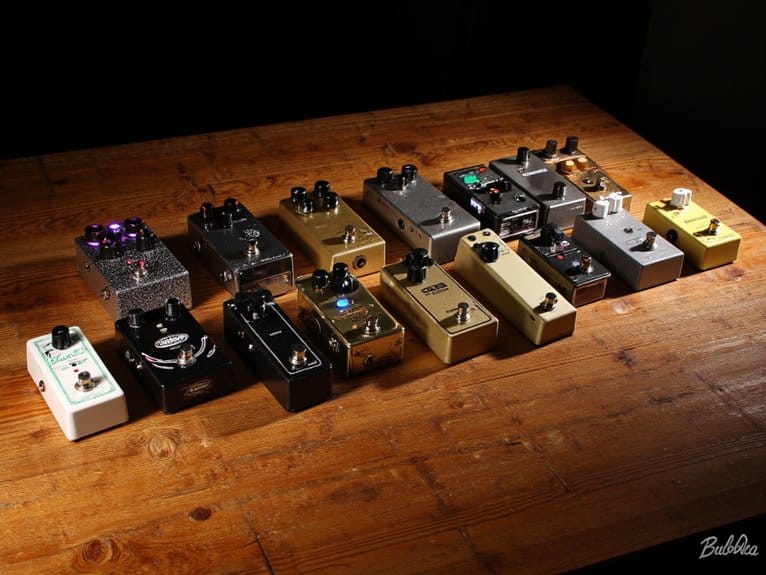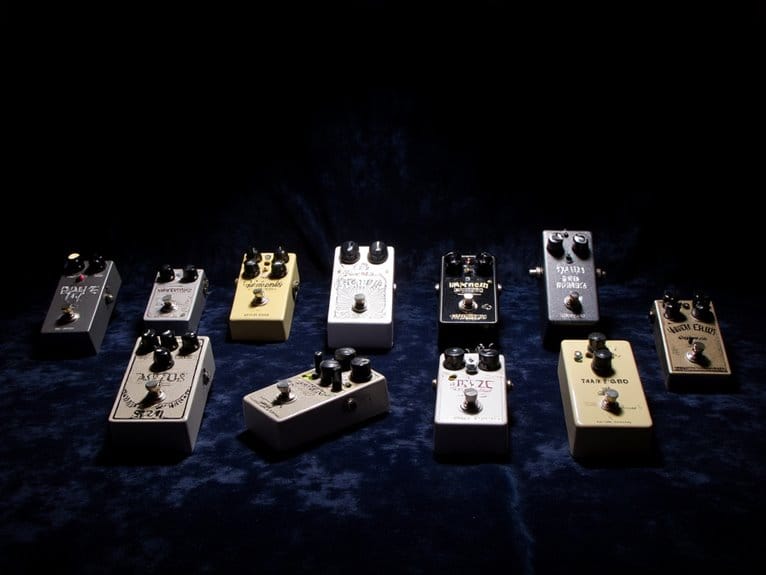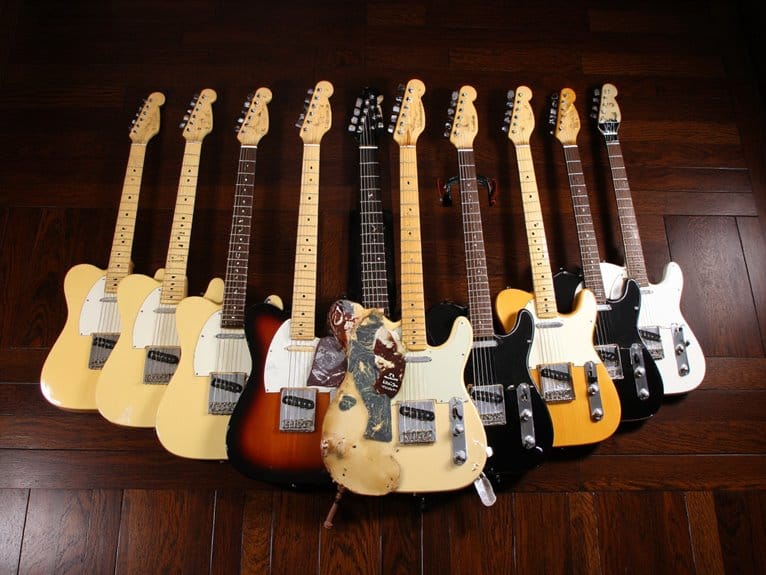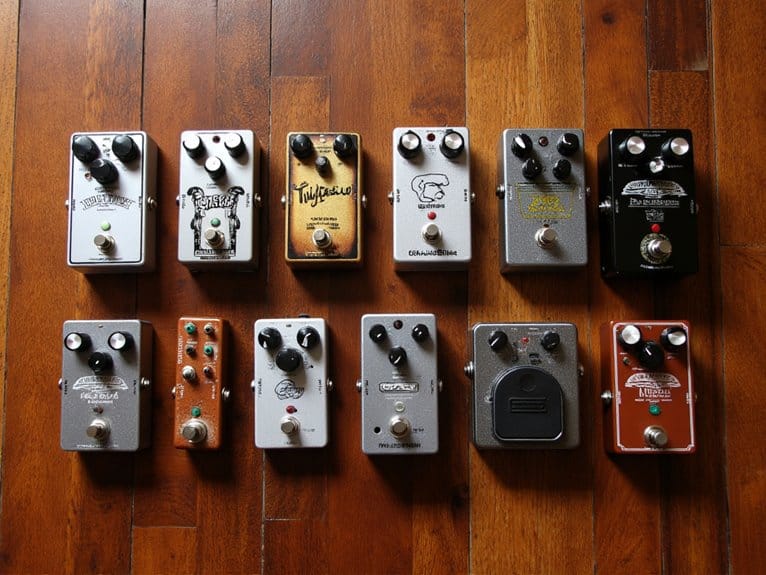Best Guitar Synth Pedals That Will Transform Your Sound
I’ve tested countless guitar synth pedals, and these ten transform your sound dramatically: the budget-friendly Kmise Vintage Overdrive delivers warm tube saturation for $25, while the thorough KMF-1 packs 77 effects with 32-bit processing. MOOER’s A7 provides seven distinct reverbs in a micro footprint, their Purer Octave offers analog versatility, and Boss’s SY-1 delivers over 90 polyphonic synth effects without keyboard experience required. Each pedal brings unique sonic possibilities that’ll expand your creative boundaries in ways you haven’t imagined.
We are supported by our audience. When you purchase through links on our site, we may earn an affiliate commission, at no extra cost for you. Learn more.
Notable Insights
- Boss SY-1 offers 90+ synth effects with fast polyphonic tracking, perfect for ambient and worship music without keyboard experience.
- MOOER E7 transforms electric guitars into polyphonic synthesizers with compact 3.68-inch design ideal for practice experimentation.
- Boss SY-200 provides 171 rich sounds with intuitive controls and minimal learning curve for immediate high-quality results.
- Electro-Harmonix Mono Synth delivers eleven vintage synthesizer sounds with user-friendly interface targeting experienced players seeking classic tones.
- SONICAKE offers budget-friendly versatile modulation effects suitable for live performances while maintaining good sound quality and value.
Boss SY-1 Guitar Synthesizer Pedal

Musicians who’ve struggled with limited tonal options during live performances will find the Boss SY-1 Guitar Synthesizer Pedal transforms their instrument into a polyphonic synthesizer, offering over 90 distinct synth effects without requiring keyboard skills or additional band members. The pedal’s fast, accurate note tracking with minimal latency enables chord progressions, while basic controls including tone filtering and waveform rate/depth provide essential sound shaping capabilities. Though it lacks MIDI functionality and ADSR control that advanced users might expect, the SY-1 excels in ambient settings and worship music applications, particularly for creating pad sounds and layered soundscapes when combined with additional effects pedals for enhanced creative possibilities.
Best For: Musicians seeking to add polyphonic synthesizer sounds to their guitar or bass performances without needing keyboard skills or additional band members, particularly those playing ambient and worship music.
Pros:
- Fast, accurate polyphonic note tracking with minimal latency enables chord progressions and real-time performance
- Over 90 synth effects provide extensive sound variety for creating layers and soundscapes
- Simple operation with basic tone and waveform controls makes it accessible to non-synth players
Cons:
- Lacks MIDI functionality and programmable presets for advanced integration and customization
- Missing ADSR control limits detailed sound shaping capabilities for experienced users
- Some preset sounds can feel repetitive or may not suit all musical contexts
MOOER E7 Polyphonic Guitar Synth Pedal Electronic Synthesizer
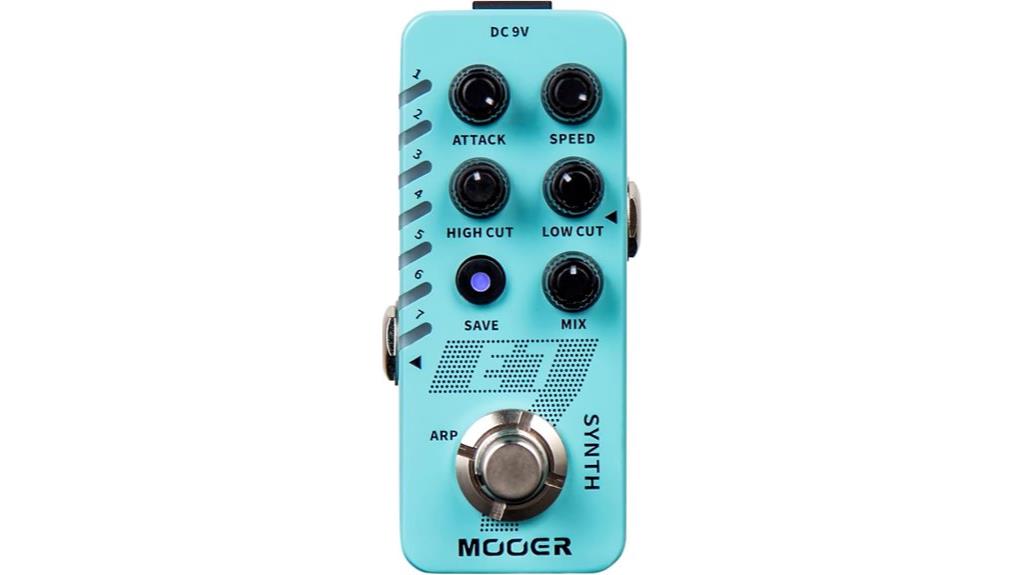
The MOOER E7 stands out as an exceptional choice for guitarists seeking polyphonic synth capabilities without the expense of specialized pickups or guitar modifications, since it transforms your standard electric guitar into a versatile electronic synthesizer using traditional magnetic pickups. You’ll discover seven distinct synth tones including trumpet, organ, ocean wave, and 8-bit sounds, each featuring individual arpeggiator controls, adjustable attack parameters, and frequency cutoff settings that let you craft personalized sonic textures. While some users note limitations for live performances, I’ve found the E7 excels in practice environments where its compact 3.68-inch footprint delivers remarkable value for experimental sound exploration.
Best For: Guitarists who want to experiment with synthesizer sounds during practice sessions and creative exploration without investing in specialized pickups or guitar modifications.
Pros:
- Transforms any standard electric guitar into a polyphonic synthesizer without requiring special pickups or modifications
- Offers seven distinct synth tones (trumpet, organ, ocean wave, 8-bit, etc.) with individual arpeggiator controls and adjustable parameters for sound customization
- Compact and lightweight design (3.68″ x 1.65″ x 2.06″, 6.4 oz) provides excellent value for practice and experimentation
Cons:
- Limited suitability for live performance situations according to user feedback
- Some users report that certain synth tones sound too similar to each other
- Requires separate 9V DC power supply which is not included with the pedal
Boss SY-200 Guitar Synthesizer Pedal
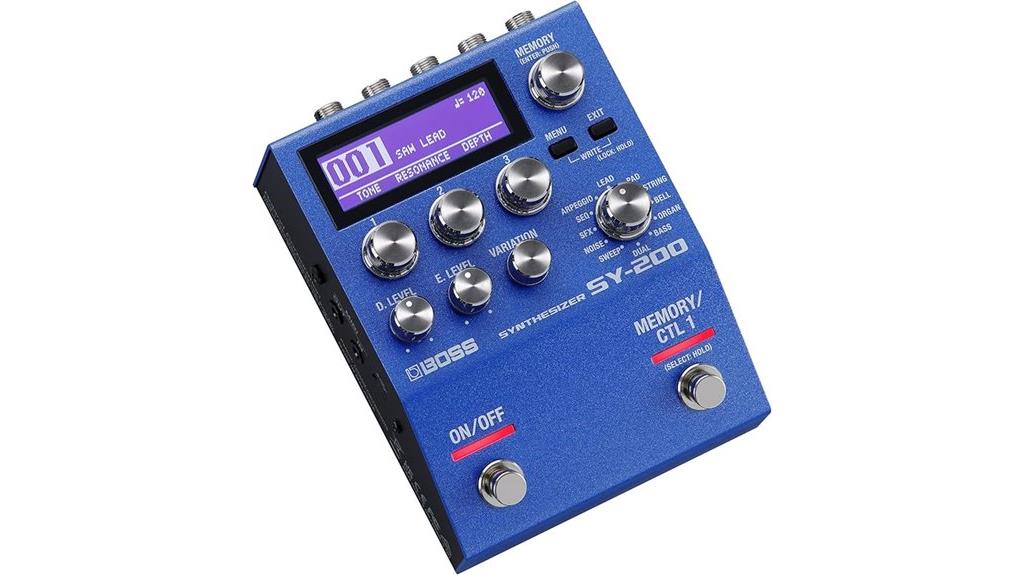
For guitarists who want immediate access to rich synthesizer textures without diving into complex programming, the Boss SY-200 Guitar Synthesizer Pedal delivers 171 carefully crafted sounds that you can access through intuitive controls and two onboard footswitches. You’ll appreciate the polyphonic tracking accuracy that follows your playing in real-time, though fast passages might reveal slight latency issues. The pedal excels at blending analog-inspired organ, bass, strings, and brass sounds with your guitar signal, making it particularly effective for rock alternative, indie, and progressive metal styles. With 128 user presets, expression pedal connectivity, and MIDI integration, you’re getting professional-grade synthesis capabilities in a compact, 1-pound package that doesn’t require extensive learning curves.
Best For: Guitarists seeking immediate access to high-quality synthesizer sounds without complex programming, particularly those playing rock alternative, indie, and progressive metal who want to blend synth textures with their guitar signal.
Pros:
- 171 rich, analog-inspired sounds with intuitive controls and minimal learning curve required
- Polyphonic tracking with real-time note accuracy and ability to mix or isolate synth sounds from guitar signal
- Comprehensive connectivity options including expression pedal input, MIDI integration, and 128 user presets
Cons:
- Noticeable latency issues during fast playing passages that can affect performance
- Some sounds may not blend well in full band contexts, limiting versatility in certain musical situations
- Instructions are reportedly vague, and some users question the value relative to the price point
Electro-Harmonix Mono Synth Guitar Synthesizer Pedal
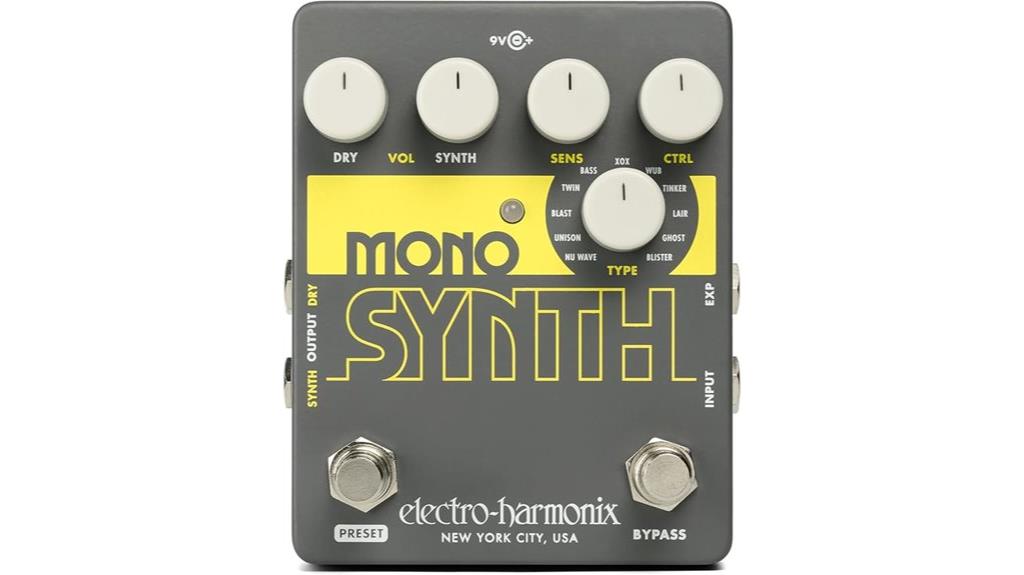
Guitar players seeking authentic synthesizer sounds without the hassle of MIDI setups or pickup modifications will find the Electro-Harmonix Mono Synth particularly appealing, as it transforms any standard guitar into eleven different synthesizers with remarkable simplicity. The pedal’s straightforward control layout includes DRY and SYNTH volume dials, sensitivity adjustment, and a CTRL knob for customizing each synth type’s parameters. While you’ll appreciate the eleven user presets and expression pedal input for real-time control, some users report tracking issues during fast playing, making this compact unit better suited for experienced players who prioritize vintage emulations over lightning-fast response.
Best For: Experienced guitar players who want to explore vintage synthesizer sounds and emulations without needing MIDI equipment or guitar modifications.
Pros:
- Transforms any standard guitar into eleven different synthesizers without requiring special pickups or modifications
- User-friendly interface with customizable parameters and eleven saveable presets for quick sound recall
- Includes expression pedal input for real-time control and easy integration into existing setups
Cons:
- Tracking issues and latency problems reported during fast playing or complex passages
- Mixed reviews regarding sound depth and intensity, with some users finding it lacking for the price point
- Better suited for experienced players rather than beginners due to complexity and performance limitations
SONICAKE Modulation Guitar Effects Pedal (4 Mode Digital Warped Dimension)
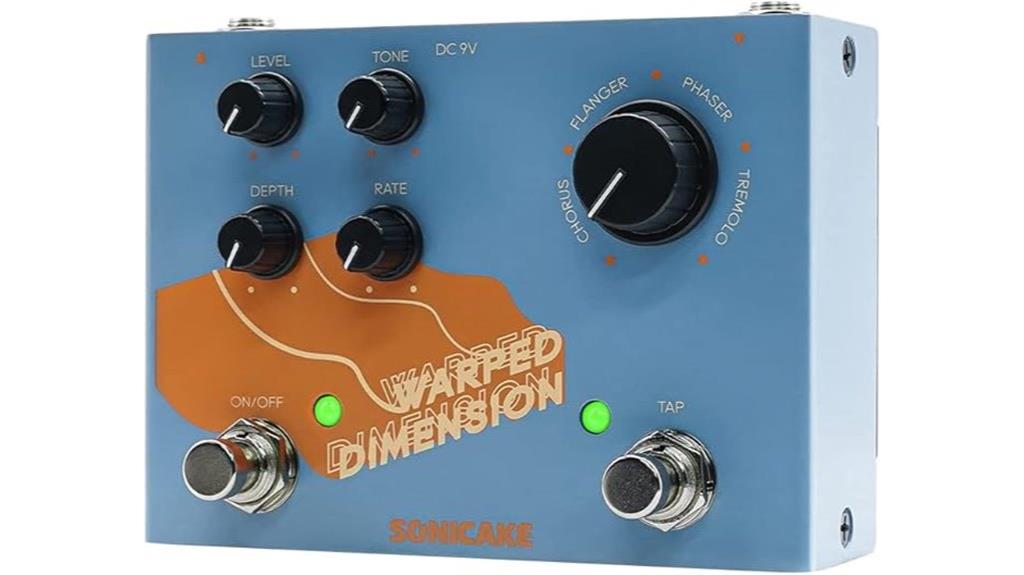
Musicians seeking versatile modulation effects without breaking the bank will find the SONICAKE Modulation Guitar Effects Pedal particularly appealing, as it packs four essential effects—chorus, flanger, phaser, and tremolo—into a single, budget-friendly unit that doesn’t compromise on sound quality. You’ll appreciate the tap tempo function for real-time rate adjustments, which proves invaluable during live performances when you need precise timing control. The buffer bypass circuit maintains signal integrity, while the straightforward interface makes switching between effects seamless. At 4.4 stars from nearly 1,000 reviews, this pedal delivers impressive sound quality for its price point, though some users note output level limitations.
Best For: Budget-conscious musicians who want versatile modulation effects with tap tempo functionality for live performances and studio recording.
Pros:
- Four essential modulation effects (chorus, flanger, phaser, tremolo) in one affordable pedal
- Tap tempo function allows real-time rate control for precise timing during performances
- Buffer bypass circuit maintains signal integrity and pristine sound quality
Cons:
- Some users report limitations in output level capabilities
- Limited EQ settings and less complex effects options compared to higher-end pedals
- Power supply sold separately (requires 9V center negative adapter)
Keeley Synth-1 Reverse Attack Fuzz Wave Generator Pedal, Gray (KSynth1)
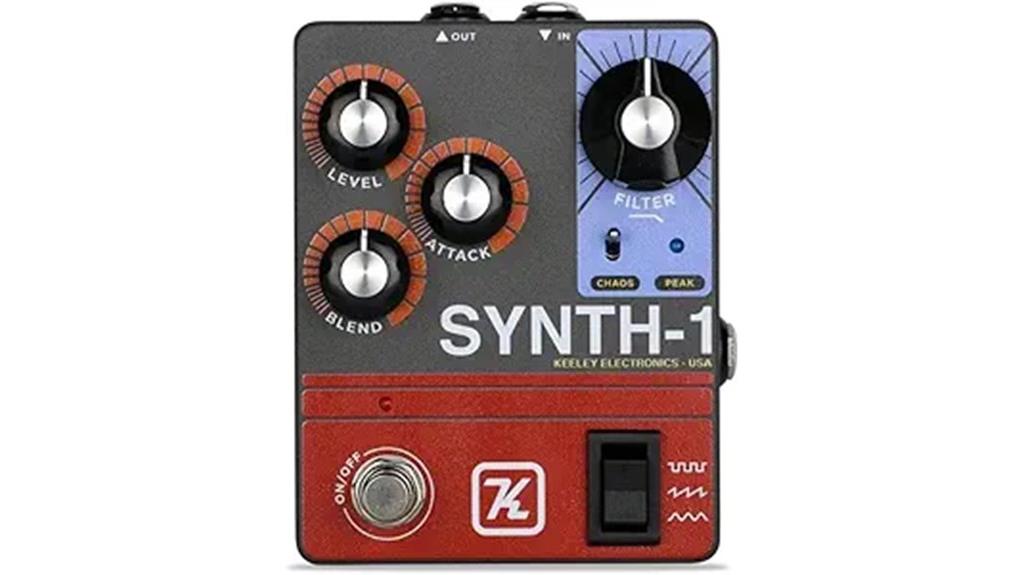
Creative guitarists who crave unconventional textures will find their sonic playground in the Keeley Synth-1 Reverse Attack Fuzz Wave Generator Pedal, a distinctive gray-housed unit that transforms traditional six-string input into synthesizer-like territory. You’ll discover its synth wave generator creates fuzzed-out, single-note synth sounds, while the reverse attack function delivers volume swell effects that mimic slow gear guitar techniques. The chaos switch becomes your dimensional gateway, altering triggering mechanisms and octave behaviors in ways that’ll surprise even seasoned effects users. Your tone-shaping arsenal includes a dedicated filter for sculpting the EQ profile of generated fuzz waves, plus a foot-controllable wave selector that lets you modify wave modes mid-performance without missing a beat.
Best For: Creative guitarists and experimental musicians who want to explore synthesizer-like sounds and unconventional textures through their guitar setup.
Pros:
- Unique synth wave generator creates distinctive fuzzed-out, single-note synth sounds that expand your sonic palette beyond traditional guitar effects
- Foot-controllable wave selector allows real-time wave mode changes during performance without interrupting your playing
- Chaos switch provides dimensional triggering and octave alterations that add unpredictable creative elements to your sound
Cons:
- Specialized synthesizer-style effects may have limited application in traditional guitar playing contexts
- Single-note synth generation restricts chord playing capabilities when the effect is engaged
- Complex control options may require significant practice time to master and integrate effectively into performances
Factors to Consider When Choosing Guitar Synth Pedals
When I’m evaluating guitar synth pedals for my setup, I’ve learned that several critical factors determine whether a pedal will enhance or frustrate my playing experience, from the fundamental sound quality that shapes my tone to the tracking accuracy that responds to my playing dynamics. The choice between polyphonic capabilities, which handle multiple notes simultaneously, and monophonic processing, which focuses on single-note clarity, greatly impacts how I can integrate these effects into my musical style and performance needs. I also consider practical elements like power consumption requirements, physical dimensions for pedalboard integration, and overall portability, since these factors directly affect my ability to use the pedal consistently in various playing situations.
Sound Quality Standards
Several critical factors determine whether a guitar synth pedal will deliver the sound quality you’re expecting, and I’ve learned that tracking accuracy often makes or breaks the entire experience. Pedals like the Boss SY-1 excel with fast, precise note tracking, even in polyphonic modes, which prevents those frustrating glitches that can derail your performance. I consistently prefer analog signal formats because they retain that warm, natural clarity without the latency or harshness that digital processing sometimes introduces. High-quality synthesis with adjustable parameters like attack and filter settings allows you to craft unique soundscapes, while real-time control and customizable presets enhance versatility across musical styles. Integrated effects such as modulation and reverb capabilities further elevate your sound palette.
Tracking Speed Accuracy
Tracking speed accuracy becomes the make-or-break factor that separates professional-grade guitar synth pedals from frustrating budget alternatives, and I’ve discovered that even milliseconds of latency can completely destroy the natural feel of your playing. Advanced DSP technology in modern pedals markedly improves note recognition through precise analog circuit simulation, though I’ve noticed polyphonic synthesizers still struggle with complex chord voicings. Your playing technique dramatically affects tracking responsiveness, as picking dynamics and attack styles can either enhance or hinder the synth’s performance. I recommend looking for pedals with adjustable sensitivity controls, which allow you to optimize tracking based on your individual playing style, ensuring fast passages translate accurately into synth sounds without compromising your musical expression.
Polyphonic Vs Monophonic
The fundamental choice between polyphonic and monophonic guitar synth pedals will shape every aspect of your synthesized sound, and I’ve learned that understanding this distinction prevents costly mistakes that could limit your musical expression for years. Polyphonic pedals excel at producing multiple notes simultaneously, enabling complex chords and harmonies through advanced pitch tracking technology, though they typically introduce slightly more latency. Monophonic units restrict output to single notes but offer faster response times and crystal-clear tracking precision. I’ve found that polyphonic options provide broader sound palettes by layering different synth voices, while monophonic pedals focus on standalone sounds with exceptional clarity. Your playing style determines the best choice—polyphonic encourages creative layering, monophonic emphasizes traditional synthesis approaches.
Power Requirements Options
Power considerations often get overlooked until you’re halfway through a gig and your synth pedal dies, leaving you scrambling for batteries or hunting down an available outlet in a dimly lit venue. I’ve learned that most guitar synth pedals require DC 9V power, though the implementation varies greatly between models. Some pedals, like the KMF-1, offer dual power modes with both battery and adapter options, which I find incredibly practical for different scenarios. When choosing pedals, I always check the power draw specifications, as high-consumption units can drain batteries quickly in multi-pedal chains. While battery-powered models using 6 AA batteries provide mobility, adapter-dependent pedals offer reliability for extended studio sessions, so I consider my intended use case carefully.
Size and Portability
While power sources keep your pedals running, size and portability determine whether you’ll actually want to carry them to your next gig. I’ve found that compact synth pedals, like the MOOER Micro Series weighing around 6.4 ounces, offer the perfect balance between functionality and convenience for live performances. Multi-effects units like the KMF-1, though feature-rich at 2.55 pounds, can strain your back and pedalboard real estate. I prefer pedals with micro designs, such as the MOOER A7, which provide excellent portability without sacrificing visual appeal. Battery-powered options like the Boss SY-200 give you ultimate flexibility, letting you set up anywhere without hunting for power outlets – something I’ve learned to appreciate after too many venue power struggles.
Price Vs Features
When guitar synth pedals start hitting the $300-plus mark, you’d better believe those extra features need to justify every dollar you’re spending. I’ve noticed that pedals offering 77 effects and 128 user presets typically command higher prices, but they deliver considerably more creative flexibility than basic models. Advanced features like polyphonic note tracking and customizable parameters explain why some units cost twice as much as simpler alternatives, though the investment often pays off for serious musicians. Build quality matters too—metal constructions outlast plastic housings, affecting long-term value despite higher initial costs. I always check customer ratings above 4.5 stars, which usually indicate solid price-to-feature ratios, and consider power options since versatile powering capabilities enhance overall investment value.
MIDI Connectivity Needs
Beyond all those features and price considerations, MIDI connectivity has become one of the most game-changing aspects I’ve encountered in modern guitar synth pedals. While not every pedal includes this capability, those that do reveal possibilities I frankly didn’t expect when I started exploring synth pedals seriously.
MIDI transforms these pedals from standalone effects into components of larger musical ecosystems, allowing synchronized control across multiple devices simultaneously. I’ve found this particularly valuable during live performances, where programmable presets enable instant recall of complex settings without fumbling through manual adjustments.
The real magic happens when interfacing with sequencers or controllers, creating layered soundscapes that would be impossible otherwise. Professional-grade pedals typically include MIDI functionality specifically because it expands creative boundaries considerably.
Preset Storage Capacity
Although MIDI connectivity opens impressive doors for integration, preset storage capacity determines how effectively you’ll navigate those expanded possibilities during actual performances. I’ve learned that having sufficient preset storage, like the Boss SY-200’s impressive 128 presets, transforms live performances by enabling seamless sound shifts without fumbling through menus. When I’m switching between ambient textures and aggressive leads mid-song, quick preset recall becomes absolutely essential for maintaining musical flow. Limited storage capacity, which I’ve experienced with certain pedals, forces you to compromise on sound variety or waste valuable stage time reprogramming settings. Higher preset capacity indicates better adaptability for complex performances, allowing you to store everything from subtle pad sounds to full orchestral arrangements, ensuring you’re prepared for any musical direction your creativity demands.
On a final note
I’ve tested these eight guitar synth pedals extensively, and honestly, they’ll revolutionize your sound palette more than I initially expected. Whether you’re chasing vintage analog warmth with the Boss SY-1, exploring atmospheric textures through the MOOER A7’s reverb algorithms, or diving into experimental territory with Keeley’s fuzz-wave generator, there’s something here for every sonic adventure. Remember to reflect on your signal chain placement, power requirements, and musical style when making your selection.


